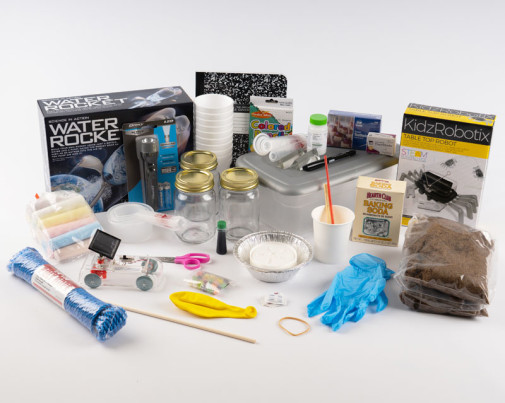We use cookies to make your experience better. To comply with the new e-Privacy directive, we need to ask for your consent to set the cookies. Learn more.
Exploring the Building Blocks of Science Book 4 Kit
- Small parts. Not for children under 3 years.
- Children under 8 years can choke or suffocate on uninflated or broken balloons. Adult supervision required. Keep uninflated balloons away from children. Discard broken balloons at once.
Kit includes nitrile gloves, jellybeans, colored pencils, paper cup, Styrofoam cups, baking soda, aluminum pie plates, science notebook, peat moss, salt and pepper packets, plastic kit box and cover, Borax, chalk pastels, polypropylene rope, dowel rod, glass jars, LED flashlight, glass prism, permanent black marker, extra-large balloons, rubber band, straw, toothpicks, round tip scissors, thumbtacks, solar powered car, 4M water rocket kit, and a 4M Table Top Smart Robot. You supply acetic acid (apple cider vinegar), cornstarch, Insect Lore Butterfly Garden (item 003539), Grow-A-Frog Kit (item 017139), white construction paper (or white paper/wall), acetone (or nail polish remover), and vegetable oil. A wind turbine kit is an optional purchase for the “Just for Fun” activity in chapter 16.
This kit contains over 30 items for experiments in the Building Blocks of Science Book 4, including colored pencils, measuring cups, measuring spoons, solar powered car, science notebook, table top smart robot, polypropylene rope, and so much more! With the use of these items, students conduct experiments to help them learn about chemical bonding, states of matter, sound vibration, renewable energy, recycling, building a robot, and more.
Items listed in this section tend to be complete science programs with a teacher and student component, requiring few supplements besides science supplies.
This is the long-awaited complete curriculum from Gravitas Publishing. Dr. Keller has taken the topics used in her Focus on Science series and combined them into grade-level appropriate curriculum. At this time, grades 1 through 5 are available; keep watching for grades 6 through 8.
At the younger grades, this yearlong program includes three books a student text, lab workbook, and teacher manual. Student Texts vary in length and are divided into five topical areas Chemistry, Biology, Physics, Geology, and Astronomy; the topics are then divided into four chapters each, for a total of 22 chapters per book (introductory and concluding chapters round out the total). The book is printed in full color and incorporates the same adorable illustrations and characters found in the Focus on Science series, but these take each topic to greater depth. Each chapter is divided into numbered sections, and each could be used as one daily lesson. The number of sections vary by chapter from four to eight. Textual information is printed in a larger font for easy reading, there is plenty of white space so your visual learners won't be overwhelmed, and new vocabulary words are printed in red. The very last lesson of each chapter is a summary, so that students can review all of the information for that chapter. Softcover.
The Laboratory Notebook is a very important part of the program. This consumable book offers 44 experiments intended to complement the chapters found in the student text. Each experiment is divided into five steps to help students with the scientific process. Step one is 'Think About It,' and students are asked to write down what they think will happen in the experiment (hypothesis). Step two is 'Observe It,' in which students are asked to write down details about what they see happening. Step three is 'What Did you Discover,' where students are asked to answer some questions concerning their experiment. Step four is 'Why?' and offers a brief discussion on the topic of the experiment and what you might have observed. 'Just for Fun' is step five and has an extra activity or experiment for the student to do (these experiments are included in the total of 44 experiments). The black and white pages of the lab notebook are formatted for students to fill in the information as they work through the activity or experiment and permission is given for photocopying within a family.
The Teacher's Manual is a guide to the experiments found in the lab notebook. A complete materials list (items from your home or easily accessible) is given at the front of the book for convenience of preparing. Listed for each experiment is the materials list, objectives, and additional information for each step of the experiment given in the lab notebook. The experiments can usually be done in an hour or less.
If you are looking for a good science course that deals with the facts, Dr. Keller has proven that her materials are solid and age-appropriate. She now gives you a choice between her topical studies or doing a complete curriculum. ~ Donna
In Book 4, students will look at chemical reactions, matter and its states, animal cells, animal phyla, earth's cycles, ecology, waves, sound, light, refraction, and lenses.
| Product Format: | Other |
|---|---|
| Brand: | Home Science Tools |
| Grade: | 4 |
| Length in Inches: | 8.5625 |
| Width in Inches: | 13.125 |
| Height in Inches: | 19.375 |
| Weight in Pounds: | 9.5 |

